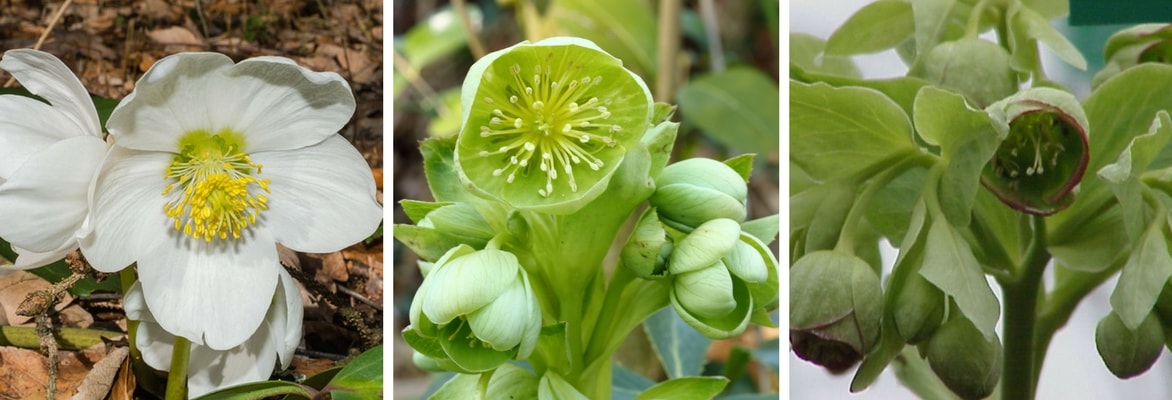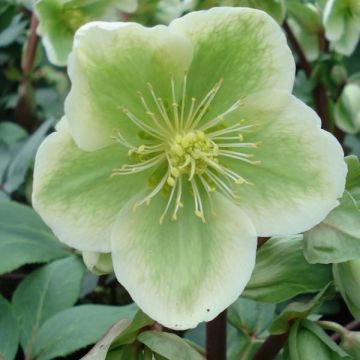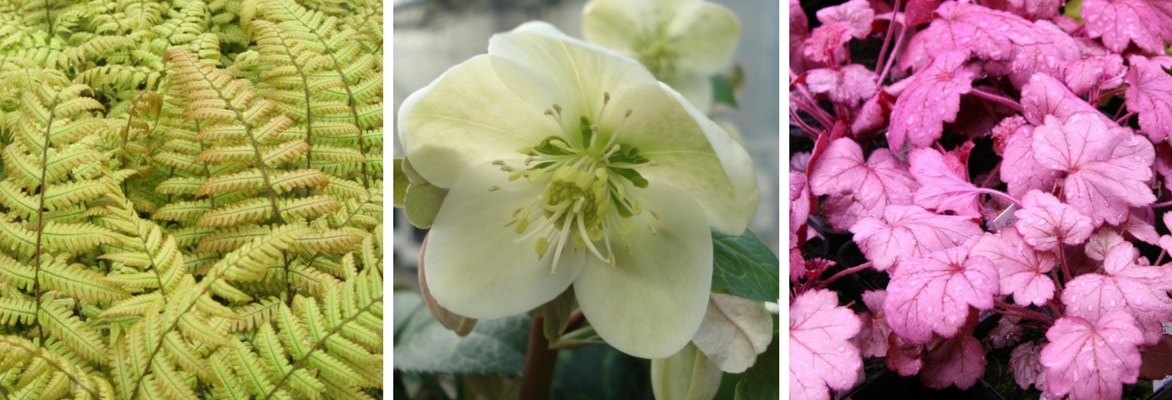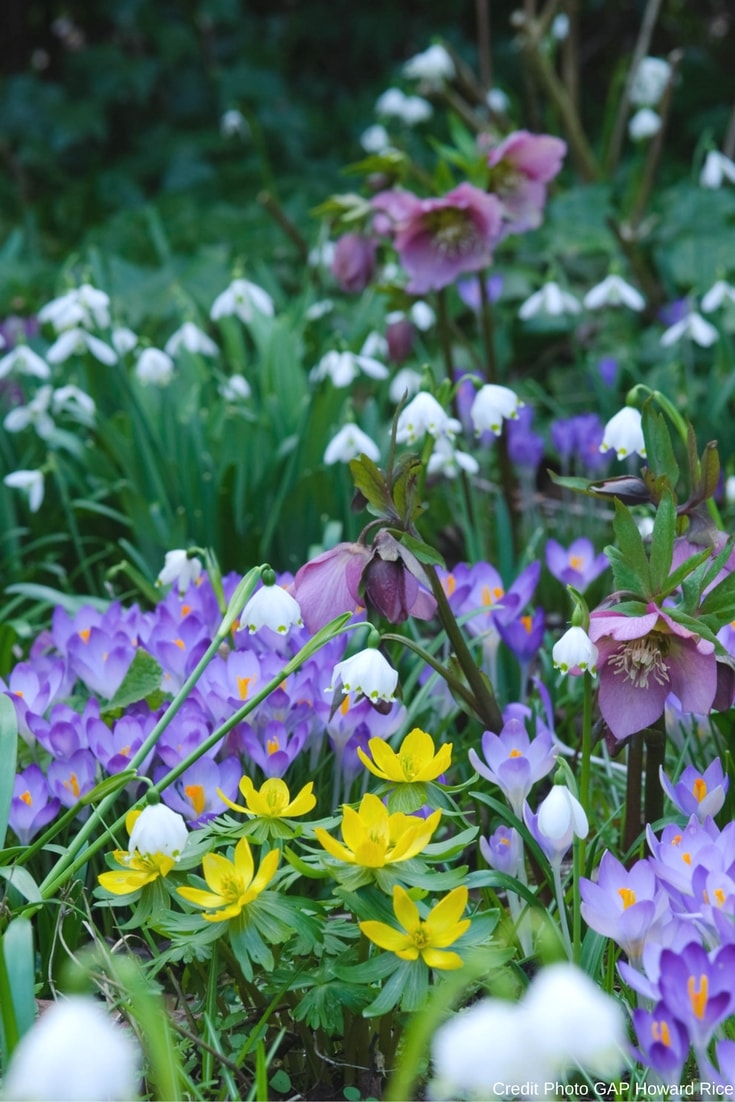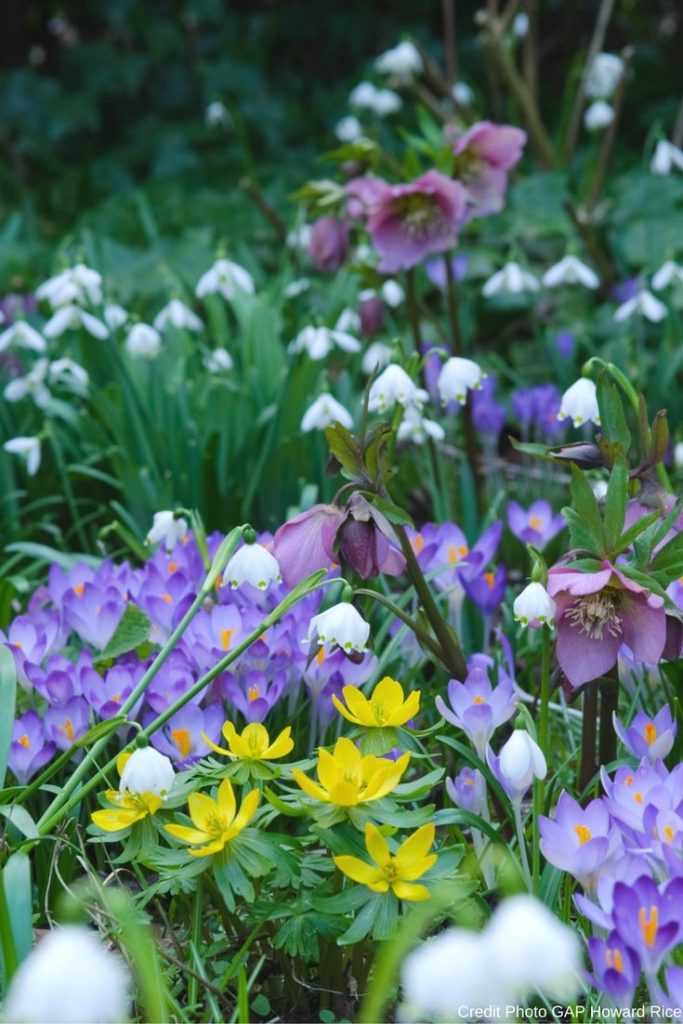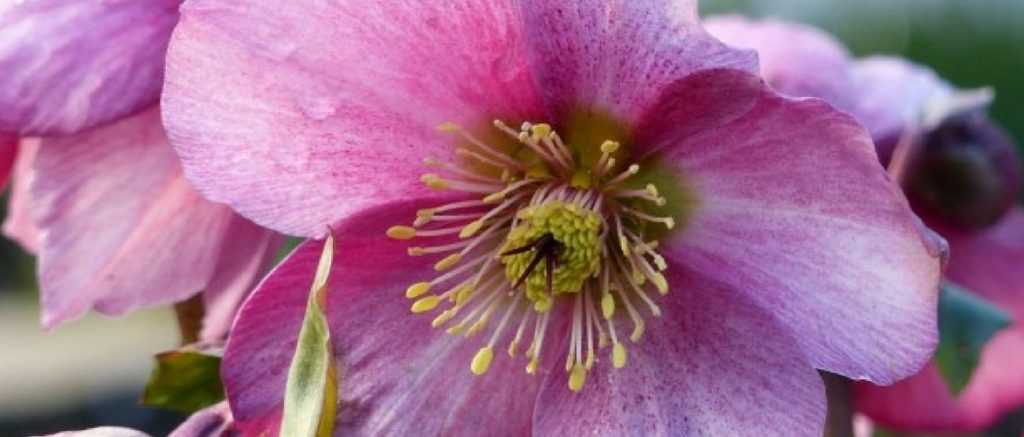
Hellebores: Planting and Growing Guide
Contents
Hellebores, in a few words
- The Hellebore or Christmas Rose is one of the few plants that flowers in midwinter: Helleborus niger will bloom as early as December, while Helleborus orientalis flowers towards winter’s end.
- Highly hardy, this perennial withstands cold and shady spots. It requires fresh, rich yet well-drained soil.
- Hellebores produce single or double flowers in a wide array of colours: pink, purple, white, yellow, green… Some varieties even boast black blooms!
- Their flowers bring colour and brightness to dark, shaded borders.
- The evergreen foliage, highly ornamental, varies from fine to broad depending on the species.
Our expert's word
The Hellebore, sometimes spelled as Elleborus, is a perennial plant that stands out by offering a rich, colourful bloom in the heart of winter. The earliest varieties begin flowering in November, while the latest finish in April. The Christmas Rose (Helleborus niger), which bears beautiful white or sometimes pink-tinged flowers, is the most well-known species. There are also many varieties of Oriental Hellebores, which produce flowers in varied colours, single or double. Discover also the Corsican Hellebore, with its yellow-green flowers and striking serrated foliage, surprisingly resistant to sun and drought.
Mysterious and fascinating, the Hellebore is a remarkable plant in more ways than one. It surprises us with its sometimes green or black flowers, which is quite rare among plants! Its life cycle seems reversed compared to other plants—it awakens in autumn or early winter, flowers, produces seeds, then goes dormant when summer arrives! Moreover, the colourful parts we assume to be petals are actually sepals, allowing them to last longer and take on rather unusual hues.
Naturally adapted to winter, this is a very hardy perennial, often tolerating temperatures as low as –15°C. It requires rich, moist but well-drained soil and thrives in partial shade. Planted at the base of deciduous trees or shrubs, it will bring a splash of colour and almost make us forget winter! It is decorative both for its flowers and its evergreen foliage. Once established, Helleborus niger and orientalis are exceptionally long-lived and disease-resistant—you’ll enjoy their blooms for many years to come!
Its flowers are used as cut flowers in bouquets, but unlike other cut flowers, they should be picked when fully open (after the nectaries have fallen).
Botany and description
Botanical data
- Latin name Helleborus sp.
- Family Ranunculaceae
- Common name Christmas Rose, Hellebore, Lenten Rose
- Flowering December to March
- Height 30 to 50 cm for most varieties, up to 80 cm for the tallest
- Exposure sun, partial shade
- Soil type deep, rich, humus-rich, moist
- Hardiness very hardy, down to –15°C
Hellebores are perennial plants with winter flowering and evergreen foliage. There are only about twenty species, mostly native to Europe and Western Asia, with a major diversity centre in the Balkans. There is even a Hellebore that grows in western China (Helleborus thibetanus)! Others come from Mediterranean islands: Helleborus argutifolius and Helleborus lividus are found in Corsica and the Balearic Islands respectively. As for the Stinking Hellebore, it is quite common in France, where it grows in forests and woodland edges.
Despite its name Christmas Rose, which more specifically refers to Helleborus niger, it is not related to the rose family (Rosaceae) but belongs to the Ranunculaceae family. The latter includes over 1,500 species, including Clematis, Delphiniums and Columbines.
The name Hellebore comes from the Greek helein: to injure, to kill, and bora: food – “the food that kills”, as it is reputed to be toxic, like most Ranunculaceae. In French, its name can also be spelled without an H: Ellébore.
Hellebores form fairly dense clumps and often reach 40 to 50 cm in height, sometimes up to 80 cm. Their stems are upright, sturdy and thick, sometimes tinged with red or purple (Helleborus niger).
This is a plant that takes time to establish, and most species only start flowering after two to five years. This is why at Promesse de Fleurs, we only sell Hellebores that are over two years old, guaranteeing flowering in the first year!
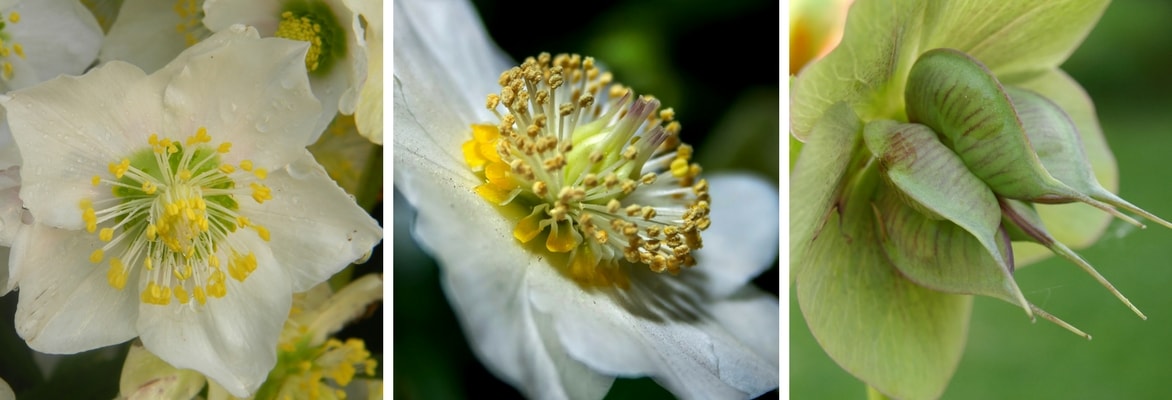
Detail of a Hellebore flower
Hellebores naturally bear white, green or purple flowers. For example, Helleborus purpurascens is a botanical species with beautiful purple blooms. From these species, horticulturists have created numerous hybrids, with flowers in pink, violet, orange, red, and even black (Helleborus orientalis ‘Black’). One of the unique features of Hellebores is their ability to produce green or black flowers, which is quite rare. There are also bicoloured varieties, delicately speckled with dots, like Helleborus orientalis subsp. guttatus. Others, like Helleborus ‘Picotee’, have purple veins.
Hellebore flowers can be single or double. The single-flowered varieties have a very natural appearance and are quite close to botanical species. As for the double-flowered varieties, created by transforming nectaries into petals, they appear very delicate and sophisticated. They resemble true jewels, especially when a fine edging highlights the petal colour, as in Helleborus orientalis ‘Double Aubergine with White Edge’.
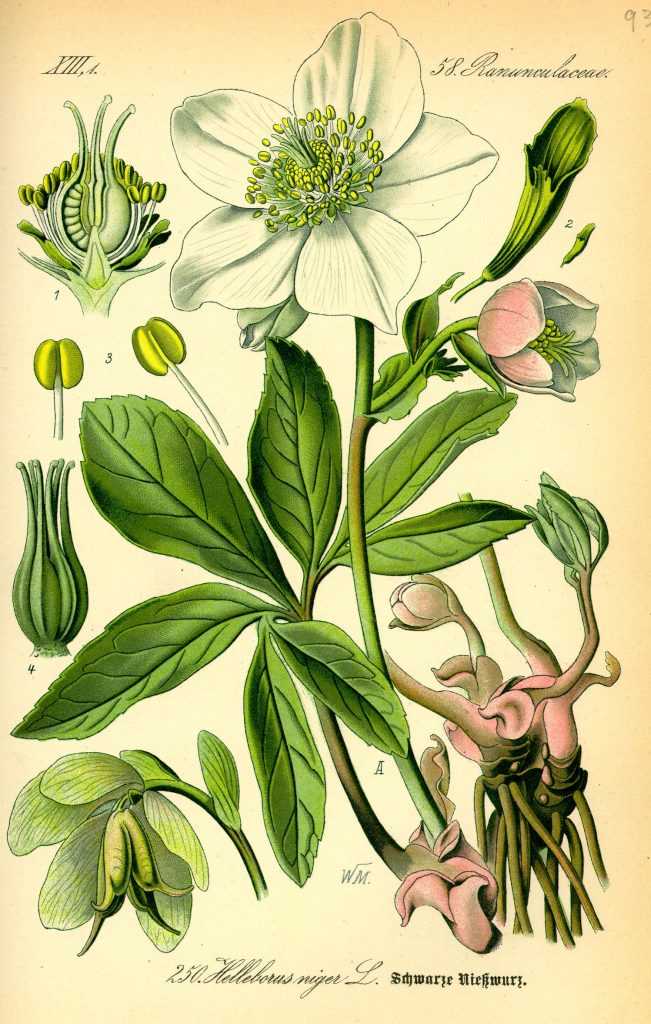
Helleborus niger, botanical illustration
Hellebore flowers are large, cup-shaped and often nod towards the ground. They consist of five sepals, which closely resemble petals. It is thanks to these modified sepals that the flower remains decorative for so long (they last longer than petals and do not wilt like them). The petals themselves have become very discreet and short. They have transformed into nectaries: they contain nectar and thus attract pollinators. They surround the stamens, which are numerous and can be yellow or white. They are decorative and create a lovely contrast when the flowers are black or dark.
Hellebore flowers are nectar-rich and attract pollinators. They are precious in winter when food is scarce for insects.
Some species flower as early as November, like Helleborus foetidus. Others in late winter, like Helleborus orientalis. The flowers are usually single, but horticulturists have developed many double-flowered varieties (mainly in Helleborus orientalis).
Hellebore foliage is often evergreen, although there are also some deciduous species, like Helleborus purpurascens. The leaves are large and divided, with a palmate appearance. They have a varying number of segments: for example, Corsican Hellebore has leaves with three broad, toothed segments, while Stinking Hellebore has up to ten narrow, elongated segments. In some species, the leaves grow directly from the ground (basal leaves). In others, like Corsican Hellebore, they grow from the stems (cauline leaves).
Hellebores have thick, fleshy roots. They are sometimes black, as in Helleborus niger. Fragile, they must be handled carefully during planting or cultivation.
Hellebore fruits are not particularly ornamental. They are follicles, dry fruits that open when ripe. There can be one to fifteen, fused together. They end in a long, fine point and contain black seeds dispersed by ants. Self-seeding easily produces new forms and colours.
Finally, Hellebores are reputed to be toxic. This is true if ingested (but who would have the odd idea of eating them?). It is often advised to handle them with gloves… a precaution few gardeners take, we assure you!
The species
Botanical Species
The Stinking Hellebore gets its name from the unpleasant smell emitted by its leaves when crushed. It grows wild in France, mainly in woodland areas. It bears small greenish-yellow flowers with purple edges, nodding towards the ground. Unlike the Lenten Rose or Christmas Rose, it thrives in dry soils. It boasts beautiful evergreen foliage, very fine and deeply cut.
→ Learn more with our video on the Stinking Hellebore
Known as the Christmas Rose, or Black Hellebore due to the colour of its roots. This is the most well-known species, but also the most delicate to cultivate. It is shorter than other species, reaching only 30 cm in height. It produces beautiful pure white flowers, sometimes tinged with pink, which brighten up its dark green foliage. There are also double-flowered varieties.
This species grows naturally in Corsica and Sardinia, hence its French name: Corsican Hellebore. It is one of the largest Hellebore species, often reaching 50 cm in height, but can grow up to 1.20 m in ideal conditions when in flower. From January to April, it produces bright green flowers. Its stems bear handsome dark green leaves, usually evergreen but may be deciduous in harsh winters. This Hellebore tolerates full sun and drought. A great choice if you lack a shady spot for growing Hellebores!
Also called the Lenten Rose, this is one of the most beautiful species, offering the widest colour range. There are many hybrids, including stunning double-flowered varieties. All equally magnificent, these cultivars mainly derive from this species, leading botanists to rename it Helleborus x hybridus.
The Lenten Rose grows to about 50 cm tall. It blooms in late winter, for two to three months. Its flowers nod towards the ground. The petals are creamy white, turning pinkish-purple, creating a striking contrast with the numerous yellow stamens they surround. Its leaves are evergreen and dark green.
This species originates from the Balearic Islands, specifically Majorca. Like the Corsican Hellebore, it enjoys sunny spots and dry soils. It reaches 45 cm in height. Its leaves are green with a bluish tint. In late winter, it bears green flowers tinged with pink. However, it is less hardy than other species. It’s best grown in mild climates.
Hybrids
This hybrid, a cross between the Christmas Rose and the Corsican Hellebore, is grown for both its abundant white flowers and its decorative evergreen foliage. It is a very vigorous and resilient variety.
This hybrid results from a cross between Helleborus argutifolius and Helleborus lividus. With parents native to Corsica and the Balearics, it tolerates full sun and dry soils. In late winter, it bears pale green flowers, sometimes tinged with pink. Its blue-grey foliage with pale veins is carried on burgundy stems.
The main varieties of hellebores
Horticulturists have developed numerous hybrids, often from Helleborus orientalis. However, it’s important to note that their flower colours may vary slightly. These are not always stable, as Hellebores are grown from seed rather than through vegetative propagation (cuttings, etc.), the only method that produces strictly identical plants.

Helleborus ericsmithii Magic Leaves
- Height at maturity 30 cm
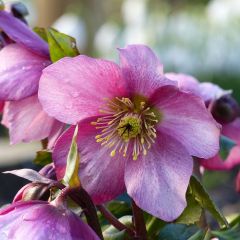
Helleborus Madame Lemonnier
- Height at maturity 30 cm
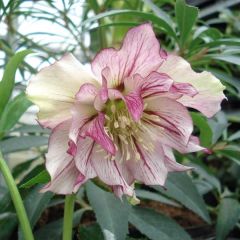
Helleborus hybridus Double Picotee
- Flowering time February to April
- Height at maturity 40 cm

Helleborus x lemonnierae 'HGC Paradenia'
- Flowering time February to April
- Height at maturity 30 cm
Most Hellebore varieties are not stabilised, so their colours may vary slightly.

Helleborus hybridus Double Aubergine White Edge
- Flowering time March to May
- Height at maturity 40 cm

Helleborus hybridus Anemone Picotee
- Flowering time February to May
- Height at maturity 40 cm

Helleborus Madame Lemonnier
- Height at maturity 30 cm

Helleborus hybridus Double White Spotted
- Flowering time March to May
- Height at maturity 40 cm
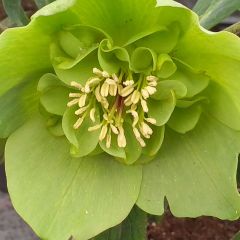
Helleborus hybridus Anemone Green
- Flowering time March to May
- Height at maturity 40 cm
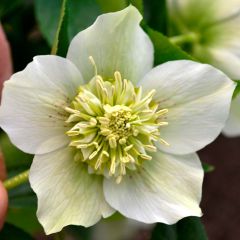
Helleborus hybridus Anemone White
- Flowering time March to May
- Height at maturity 40 cm

Helleborus nigercors Snow Love
- Flowering time March, April
- Height at maturity 30 cm

Helleborus x hybridus Black
- Flowering time March to May
- Height at maturity 40 cm
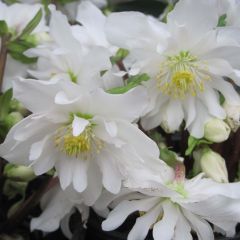
Helleborus niger Double Fashion - Christmas Rose
- Height at maturity 40 cm
For help choosing your Hellebores, follow our advice: “Hellebore or Christmas Rose: Which Variety to Choose”
Discover other Helleborus nigercors
How to plant a hellebore
Where to Plant?
Hellebores thrive in clayey, heavy but well-drained soils: your soil should not be waterlogged in winter. However, it should remain moist even in summer. Hellebores prefer rich, humus-rich soils. If your soil is rather poor, add organic matter or compost to enrich it. They favour calcareous soils, and the Christmas Rose, Helleborus niger, does not tolerate acidic soils. Conversely, the Lenten Rose thrives in acidic soil.
They prefer lightly shaded positions and dislike direct sunlight. The best option is to plant them under deciduous shrubs. This way, they will be protected from the sun in summer and receive light in winter. They beautifully adorn the base of trees and shrubs. Note, however, that the Corsican Hellebore (Helleborus argutifolius) and Helleborus x sternii enjoy sun and seem more drought-tolerant than other species.
We also recommend planting your Hellebores in a sheltered spot, protected from the wind.
When to Plant?
Hellebores are best planted in spring or autumn, two periods conducive to their rooting. Autumn is often preferred as temperatures are milder and moisture more consistent, promoting good establishment before winter. It is important to plant outside frost periods, which can hinder the development of young plants.
How to Plant?
Plant your Hellebores in groups of 3 or 5 plants, spacing them 50 to 60 cm apart. Don’t hesitate to place them on a slight mound to prevent waterlogging in winter.
If your soil is acidic, you can raise the pH by adding dolomite (crushed sedimentary rock rich in limestone). If it is clayey, add gravel or clay pebbles to improve drainage.
Here are the steps to plant a hellebore:
- Soak the root ball by immersing it in a basin of water.
- Dig a hole twice as wide as the root ball.
- If the soil is heavy, add a layer of gravel or coarse sand at the bottom for drainage.
- Enrich the soil with compost or potting mix.
- Place the root ball, keeping the crown level with or slightly above the soil.
- Backfill with a mix of garden soil, compost, and sand, then gently firm down.
- Water generously.
If you are planting young plants, often found in garden centres in pots smaller than 1 litre, your Hellebores may take a long time to establish. Sometimes, they may wait two years before flowering! At Promesse de Fleurs, the plants we offer are over two years old, ensuring flowering in the first year.
How to Care for Hellebores?
Even in summer, when Hellebores are dormant and could easily be forgotten, it’s best to water them to prevent them from drying out completely. We also recommend mulching by spreading a layer of dead leaves around the base of Hellebores to keep the soil cool and for a more attractive visual effect.
When flower buds appear, remove the old leaves. This helps showcase the new flowers, as the leaves might otherwise hide them. Additionally, cutting away old leaves reduces the risk of fungal diseases, particularly black spot caused by the Marsonia fungus.
Hellebores are indeed susceptible to black spot disease, grey mould and crown rot. These diseases indicate excessive moisture. Treat with Bordeaux mixture and consider moving the plant to better-draining soil. As for pests, they are particularly prone to aphids! Their leaves are also sometimes nibbled by slugs and snails.
Hellebores thrive in rich soil: we recommend incorporating ground horn, well-rotted manure or compost into the surface layer. This helps nourish the plant. Apply fertiliser if planted in pots.
If you’ve planted the Christmas Rose, Helleborus niger, you can also spread wood ash to slightly raise the pH. Remember, this Hellebore prefers slightly alkaline soils!
→ Learn more with Diseases and Pests of Hellebores
Possible diseases and pests
Hellebores, although quite hardy, can be affected by several diseases and pests. Among the most common diseases is black spot disease (Coniothyrium hellebori). This manifests as dark spots on the leaves, which can lead to yellowing and the dropping of affected foliage. Another frequent disease is downy mildew, which causes yellowish patches on the leaves, sometimes followed by wilting. Lastly, botrytis, a grey mould, can also affect Hellebores, particularly in damp conditions.
As for pests, aphids may suck the sap from young shoots, weakening the plant. Slugs and snails are also fond of the tender young leaves of Hellebores, causing holes and significant damage.
To prevent these issues, it’s essential to maintain good air circulation around the plants, avoiding overcrowded planting. Moderate watering is recommended, as Hellebores dislike excessive moisture, which encourages fungal growth.
→ To learn more about how to avoid these nuisances, read Diseases and Pests of Hellebores.
Propagation: sowing, division
To propagate Hellebores, two methods are possible: sowing seeds or dividing clumps.
Sowing Hellebores


Helleborus orientale Double Picotée / Anémone Blanc pur / Blanc à centre rouge / Black: stunning but not reproducible by seed.
Sowing Hellebores is not particularly complicated. However, you must follow a few simple rules and, most importantly, sow the seeds very quickly—they don’t keep well!
When propagating Hellebores by seed, there is no guarantee of obtaining a plant identical to the parent. Colour variations may occur. Additionally, you’ll need to be patient and wait a few years for them to flower. Some hybrids, such as Helleborus x nigercors, cannot be propagated by seed as they are sterile.
However, sowing is the only way to reproduce Stinking Hellebore (Helleborus foetidus), Majorcan Hellebore (Helleborus lividus), and Corsican Hellebore (Helleborus argutifolius), as they cannot be propagated by division. Fortunately, Corsican Hellebore self-seeds very easily!
Sowing in pots, under cover:
The seeds do not store well. They must be sown as soon as possible, as they lose their viability very quickly.
- Start by placing the seeds in the refrigerator for 10 to 15 days. They require this cold period to germinate.
- Fill a pot with seed compost.
- Sprinkle a few seeds on the surface.
- Cover them with a thin layer of compost.
- Gently firm the soil.
- Water lightly to moisten the substrate without waterlogging it.
- Place the pot under cover in a bright spot, ensuring the soil remains consistently moist but not soggy.
Direct sowing in the ground:
Sowing directly in the ground is possible and very simple—just cover the seeds that have fallen at the base of the Hellebore with compost. Once they’ve grown the following year, you can move the clumps to another location.
It will take two to three years before they flower.
Dividing clumps
Dividing clumps is a quicker and more reliable method than sowing. We recommend dividing Hellebores in early spring, after flowering. The Lenten Rose (Helleborus orientalis) is best divided in late summer or early autumn. Only divide the largest clumps, and handle with care, as Hellebores dislike being transplanted. Their roots are very sensitive and fragile.
- Choose a large clump to divide—it should be at least four or five years old.
- Mark the perimeter using a spade, circling the entire plant.
- Dig carefully and lift the clump from the soil, keeping as many roots intact as possible.
- Gently shake the clump to remove excess soil.
- Divide the root system in two (or more, depending on size) with a clean, sharp knife.
- Replant immediately.
- Water thoroughly to help establish the roots.
Flowering may be sparse the following year.
→ Learn more about propagating Hellebores in our guide and dividing Hellebores in our tutorial!
Combining Hellebores in the Garden
Hellebores are interesting not only for their winter flowering but also for their evergreen foliage, which can be highly decorative! You could pair Helleborus x nigercors ‘Magic Leaves’, with its striking green foliage marbled with white, alongside evergreen ferns such as Dryopteris erythrosora, and some brightly coloured Heucheras.
Because they thrive in partial shade, Hellebores do well beneath deciduous trees and shrubs. These provide shade in summer while allowing light through in winter. You could plant them at the base of Witch Hazels, which boast stunning yellow winter blooms. Hellebores also pair beautifully with trees and shrubs prized for their decorative bark, such as Prunus or Cornus.
Corsican Hellebores and Stinking Hellebores can be planted in rockeries, as they enjoy dry, stony soils and tolerate sunny spots. Plant clumps of ornamental grasses alongside them: Carex or Stipa.
Choose Hellebores that flower in late winter, such as Helleborus orientalis, and opt for colourful varieties (e.g., Helleborus orientalis guttatus Yellow). Pair them with spring bulbs like Snowdrops, Daffodils or Grape Hyacinths. Add some Winter Aconites – their bright yellow star-shaped flowers will carpet the ground. This way, your garden will be bursting with life as early as February.
For more successful planting combinations, check out our guide: “Hellebores: 7 Winning Planting Combinations”
Useful resources
- Discover the most beautiful varieties with us: explore our extensive Hellebore collection!
- Our advice: “Caring for Oriental Hellebores in 5 Simple Steps” on our blog and 7 Tips for Beautiful Hellebores.
- Article by Didier Willery on Hellebores, published in L’Ami des Jardins et de la Maison:
- Dedicated website for botanical Hellebores and Peonies, with cultivation guides and specific fact sheets
- Watch our Hellebore videos: a wonderful diversity and 5 Tips for Beautiful Hellebores
- Our fact sheets:
- “Hellebores: Reliable Choices“
- 7 Anemone-Flowered Hellebores
- 6 Double-Flowered Hellebores
- 7 Oriental Hellebores: The Darkest Varieties
- 10 Single-Flowered Hellebores
- Botanical Hellebores
- Bicolour Hellebores: 7 Varieties to Discover
- Brighten Winter with Purple-Flowered Hellebores!
- Grow Yellow-Flowered Hellebores to Illuminate Winter!
- For a Colourful Winter, Choose Pink-Flowered Hellebores!
- White-Flowered Hellebores: Perfect for Winter!
- Brighten Late Winter Gardens with Late-Flowering Hellebores
- Discover: green flowers!
- Learn more about growing Hellebores in pots in Gwenaëlle’s fact sheet
- Our fact sheet: Helleborus lemperii Joins Our Catalogue! and a New Generation of Hellebores in Our Collection
- Watch our tutorial: When and How to Prune Hellebores?
- Video – Sowing Hellebores (Rustica):
Frequently asked questions
-
Help! My Hellebore Isn't Flowering!
It is probably too young. Hellebores take a long time to establish themselves. They sometimes need more than two years before they can flower! If it's an older plant, the location might be too shady or the soil too dry. Check that its growing conditions are suitable! And be patient... Even though Christmas Roses (Helleborus niger) can flower as early as November or December, their blooms may sometimes only appear from January onwards. Similarly, some species flower later: you'll have to wait until March to enjoy the blooms of Lenten Roses!
-
The leaves of my Hellebore are falling off!
Hellebores are susceptible to fungal diseases, particularly black spot disease. The leaves may rot if there is excessive moisture or if the plant is placed in overly heavy soil. Consider relocating it to a more favourable spot. When planting, ensure good drainage by placing gravel or clay pebbles at the bottom of the planting hole. You can also plant Hellebores on a slight mound.
-
The leaves of my Hellebore are drying up... Why?
If they dry out in autumn, there's no need to worry! The old leaves will be replaced by new ones in spring. However, if this happens at another time of year, the soil is probably too dry! Spread a mulch of dead leaves around the base of your Hellebores to retain soil moisture. In summer, you can water occasionally during dry spells.
-
The flower colour differs from what was expected.
If you obtained the plant from seed, this is normal and unavoidable. Horticultural varieties are not fixed, and colours may vary. Over generations and successive sowings, the flowers evolve and their colours change slightly, becoming increasingly similar to the natural Hellebore species.
However, if it's a plant you purchased from us and the difference is very noticeable, please get in touch! We will either refund you or replace the plant.
-
Can I plant Hellebores during winter?
Yes, you can plant your Hellebore during winter, as long as you do so outside of severe frost periods. However, this depends on the variety: some species, such as Helleborus lividus, will tolerate it less well.
-
Can I Keep My Hellebore Indoors?
Yes, you can keep your Hellebore indoors for a few days to fully enjoy its flowering, but no longer! It needs cool temperatures and a well-ventilated spot.
- Subscribe!
- Contents


































